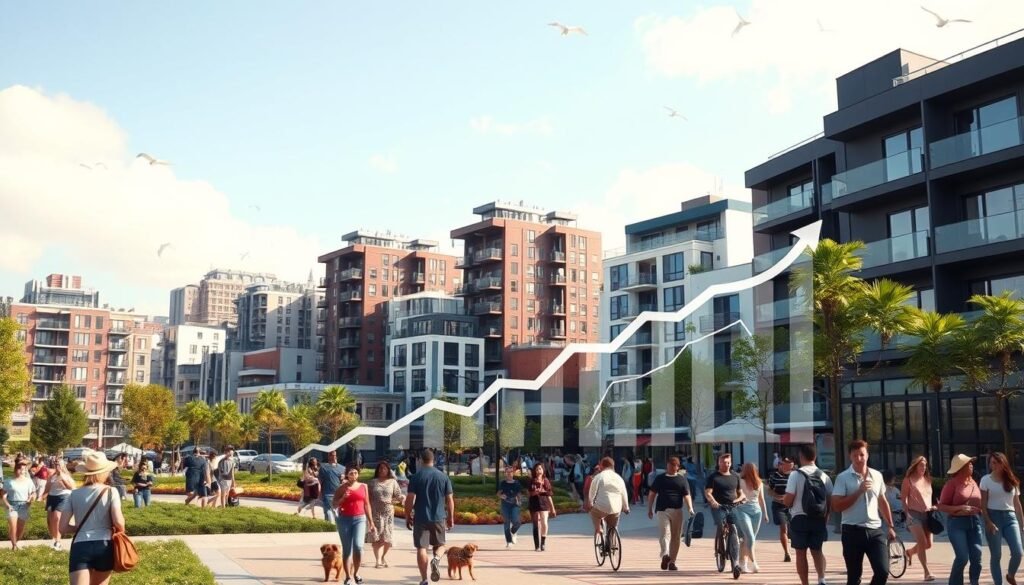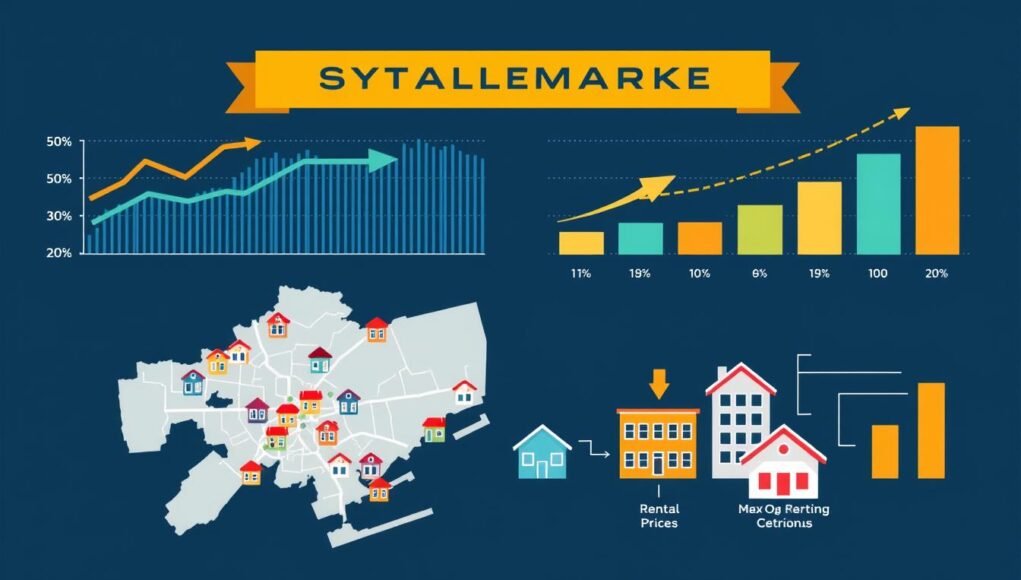Before jumping into real estate, assessing rental demand is key. Knowing about rental trends can help you achieve good rental rates and lower vacancy risks. This ensures your investment pays off.
Places with more than half the residents renting are in high demand. A high price-to-rent ratio means buying homes is costly, pushing folks to rent. Also, areas with new projects and great amenities draw renters, boosting appeal.
We will tackle what affects rental demand, such as demographic shifts and economic health. Our guide shares tips and insights for savvy property investment decisions. Dive into these factors to understand how to gauge rental demand effectively.
Key Takeaways
- Regions with over 50% residential tenants indicate higher rental demand.
- High price-to-rent ratios imply higher demand for rental properties.
- New development projects in a location attract more renters.
- Local amenities play a critical role in increasing rental demand.
- Understanding rental market analysis helps set competitive rental rates.
Understanding Key Factors Influencing Rental Demand
Understanding the real estate market is key. We look into the factors that affect how many people want to rent. Analyzing data helps investors make choices that bring in more money. We will discuss these important factors.
Demographics
Who lives in an area matters for rental demand. Looking at population size, age, and how much money people make helps. For example, places with more people or younger people often need more rentals.
- Population Growth: More people means a higher need for places to live.
- Income Levels: Rich areas might look for fancy rentals. Less wealthy areas need cheaper options.
- Age Distribution: The ages of people in an area can change what kind of rentals are in demand.
Employment Opportunities
Jobs attract renters. Areas with lots of jobs, like Fort Mill and Charlotte, see more people wanting to rent. When there are good jobs, more people move there needing homes.
- Job Market Strength: More jobs mean more people need places to rent.
- Influx of Job Seekers: New jobs bring more people looking for homes.
- Economic Stability: A strong economy keeps the rental market healthy.
Price-to-Rent Ratio
The Price-to-Rent (PTR) ratio helps decide if it’s better to buy or rent. It compares the price of buying a house to the cost of renting a similar one. A high PTR ratio means renting is often the smarter choice. But, if the PTR is low, buying might be better.
| PTR Ratio | Implication |
|---|---|
| High (Above 20) | Renting looks better when this number is high. |
| Low (Below 15) | If this number is low, buying could cost less than renting. |
Studying these factors helps investors understand rental needs in different areas. This knowledge supports making profitable decisions in real estate.
Analyzing Rental Listings and Vacancy Rates
To understand rental property demand, look at rental listings and vacancy rates. Knowing how many places are rented vs. empty gives insight into the market. It helps predict how many people will want to rent in the future.
Occupied vs. Vacant Listings
The balance between occupied and vacant listings shows the rental market’s health. When more listings are occupied, it means demand is high. This can push rents up. However, too many empty places suggest there might be too many rentals available. This can lower rent prices.
Keeping an eye on these numbers over time is important. It helps spot trends and make smart investment choices. For example, in 2023, the U.S. vacancy rate was around 6%, but it changed in different areas. Landlords need this info to adjust their plans.
Rental Listing Trends
Looking at how rental listings change over time also helps forecast demand. Websites like Zillow Rental Manager and Realtor.com Rentals show important data. They tell you about average rents, how many places are empty, and more.
Local government and the US Census Bureau offer helpful vacancy stats. These numbers help landlords set fair rents and keep their properties in good shape. It helps attract renters.
Experts suggest using sites like Apartments.com and Rentometer for deeper insights. These sites show rent prices and how they change with the seasons. Knowing this can help plan for when more people are looking to rent.
Understanding vacancy rates is key. To figure them out, multiply the empty units by 100, then divide by all units you manage. This helps manage rentals better and predict demand accurately.
For more on evaluating rental property and investing wisely, visit this link: vacancy rates.
How to Find Out Rental Demand in an Area
To find out about rental demand, begin with property sites like Rightmove and Zoopla. These sites show how many rentals are available and how long they’ve been listed. This info is a good sign of demand.
Compare the number of rentals listed to those already rented. Lots of rented properties mean high demand. Looking at how long rentals stay on the market tells you if the area is in demand.
Platforms like SpareRoom.co.uk are great for checking demand for HMOs. Also, sources like the U.S. Census Bureau and Renters Warehouse provide reliable data. These help in understanding the market.
Local economic trends are key in analyzing rental success. Things like job growth, population changes, and local developments all affect rental demand and vacancies. These factors are very important.
Here’s how some metrics stack up:
| Metric | Impact on Rental Demand |
|---|---|
| Job Growth | Positive correlation with higher rental demand |
| Population Trends | Growing populations typically increase demand |
| Rental Listings Duration | Shorter durations indicate higher demand |
| Vacancy Rates | Low rates suggest high demand |
Talking to real estate experts can give more insights into the rental market. They know the latest trends and changes affecting demand.
Good rental property analysis looks at many factors for the best decisions. Recognizing these factors is a key step in understanding rental demand in an area.
The Role of Development Projects and Local Amenities
Understanding how development projects and local amenities affect rental demand is key. It matters a lot for anyone looking into real estate investments. Analyzing the forecast for rental demand involves a close look at new schools, hospitals, and transport hubs. These factors make an area more appealing to those looking to rent.
The start of new schools and healthcare facilities can make a neighborhood more desirable. This increase in appeal boosts the demand for rentals. Also, projects like new roads or public transportation can make it easier to get around. This improves rental demand. As these developments pop up, they often lead to a stronger market for rentals. This creates more chances for investors.
Local amenities also have a big role in how attractive rentals are. Things like parks, malls, great schools, and places for fun add a lot of value. They make a place better to live and more appealing to renters. When investors do their market study, they should look at these amenities closely. They are a big sign of how much demand there is for rentals in an area.

Let’s look at how some amenities impact rental demand:
| Amenity | Impact on Rental Demand |
|---|---|
| New Schools | Raises appeal to families, therefore, boosting rental demand. |
| Healthcare Facilities | Makes an area more livable, attracting health-focused people. |
| Parks and Recreational Areas | Ups appeal for those who love the outdoors and families. |
| Transport Hubs | Makes it easier to travel, appealing to those who commute. |
In summary, knowing about local developments and amenities is crucial for predicting rental demand. Analyzing current rental trends and statistics helps. It gives investors insight into how profitable rental properties could be in a specific area.
Conclusion
Understanding rental demand forecasts is key for landlords who want to grow their business. By looking at demographics, landlords can guess who might rent based on age, family size, and how much money they make. Checking job trends in the area also tells about economic health and if people might move often.
Studying rental listings and how many places are empty shows if the market is too full. Knowing how many places are rented versus empty helps landlords market better and set good goals for their property. Also, being smart about rental trends helps create listings that stand out to people looking for a place.
Local development projects and nearby amenities really matter. If an area is getting new things like roads, parks, or shopping areas, its properties become more wanted. This link between neighborhood improvements and wanting to rent there means landlords can ask for more rent, leading to higher earnings.
Doing thorough research with Rental Market Analysis (RMA) is a must. An RMA looks at similar properties to help set the right rent prices, which decreases empty times and increases income. Keeping up with what’s happening in the market through regular RMAs shows how a property might do in the future, guiding buying choices.








